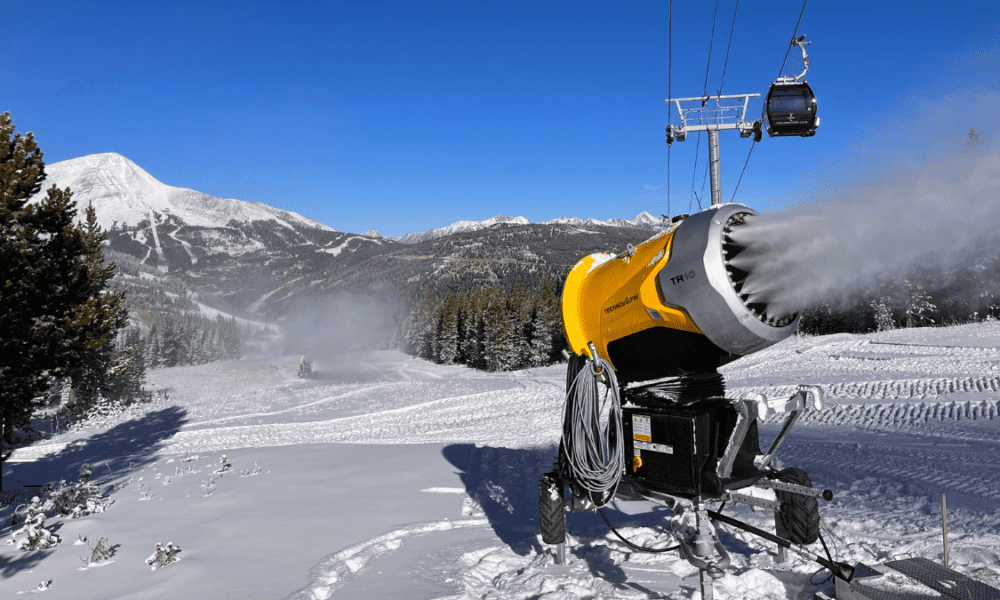Montana
Second Montana ski resort looks to turn wastewater into powder

The Spanish Peaks Mountain Club has requested a permit from the Montana DEQ.
By Justin Franz MONTANA FREE PRESS
The Spanish Peaks Mountain Club in Big Sky has asked for a permit from the Montana Department of Environmental Quality to let it turn wastewater into snow for skiing and snowboarding. The private club is the second Montana ski area to try and implement snowmaking technology that proponents say is good for the environment and skiers amid a warming climate.
More than a dozen ski areas in eight states, plus some in Canada, Switzerland and Australia, use wastewater to make powder. This past winter, the Yellowstone Club near Big Sky became the first in Montana to turn what was once sewage into snow. The Spanish Peaks Mountain Club and Yellowstone Club share a common parent company, CrossHarbor Capital Partners, but they operate as separate businesses. The Spanish Peaks terrain is operated by Big Sky Resort and accessible to the public.
If approved, Spanish Peaks Mountain Club would use the treated water to make snow on approximately 44.5 acres of groomed runs on Spirit Mountain and the Spanish Creek base area and about 40.7 acres in the Southern Comfort ski area. The ski area would mostly use the treated snow in November and December to build a base during the early season.
The project would be built out in two phases. During phase one, the ski area would use 23 million gallons of treated water per year to make about 18 to 24 inches of snow. During phase two, that would increase to 44 million gallons of water annually.
DEQ has prepared a draft environmental assessment and is accepting comments on the plan through June 6.
In an emailed statement to Montana Free Press, Spanish Peaks’ Vice President of Environmental Operations Richard Chandler wrote, “We are very excited about this effort and appreciate the Department of Environmental Quality’s careful review. The conservation community in Montana has embraced the concept of turning reclaimed water into base layer snow to reuse our precious resources, recharge the aquifer and extend cold water flow into our rivers in the late summer months. Projects like these will help add resiliency to the Gallatin River, especially during drought years.”
Chandler, who also oversees the Yellowstone Club’s environmental operations, has previously said that turning recycled water into snow is better for the environment than just releasing it into a river, which normally is what happens. By shooting it through the snowmaking equipment (it’s essentially misted onto the slopes as snow) the wastewater is treated again. Then, as it melts in the spring and enters the ground, it’s filtered a third time. Because of that, groups like the Gallatin River Task Force, Trout Unlimited, American Rivers, Great Yellowstone Coalition and the Association of Gallatin Agricultural Irrigators all supported the Yellowstone Club project.
The effort to turn wastewater into snow in Big Sky dates back more than a decade. In 2011, the Gallatin River Task Force, Yellowstone Club and DEQ teamed up to study the concept. The idea was that as climate change made the region’s snowpack more unpredictable, they could serve skiers and the watershed by making snow from treated water that is traditionally just put into rivers and other bodies of water. That winter they successfully turned a half-million gallons of wastewater into two acres of snow about 18 inches deep.
In 2020, the Yellowstone Club applied for a permit from DEQ to expand that pilot program into a permanent snowmaking operation on Eglise Mountain. The following year, the state issued a permit allowing the Yellowstone Club to turn 25 million gallons of wastewater into snow annually. Two years and $12 million later, the new system began making snow last November.
Under the current plan, 80% of the recycled water comes from the Big Sky community, and 20% comes from the Yellowstone Club. For the Spanish Peaks project, all of the water will come from the Big Sky County Water and Sewer District wastewater treatment facility.

Montana
Gianforte declares disasters in Missoula and Mineral counties after extreme thunderstorm

Montana Gov. Greg Gianforte declared disasters in Missoula and Mineral counties Friday.
Thousands are still without power after an extreme thunderstorm swept the area Wednesday night.
The governor’s declaration could make state money available to aid in restoration efforts if the counties need it. Wind that whipped up to 80 miles an hour downed trees and power lines across the counties. The full extent of the damage is not yet known.
Gianforte’s declaration noted the counties are reporting emergency costs to repair critical infrastructure. That includes water treatment, city buildings and traffic control systems.
Missoula declared its own state of emergency Thursday morning.
Montana
Unemployment claims in Montana declined last week

Initial filings for unemployment benefits in Montana dropped last week compared with the week prior, the U.S. Department of Labor said Thursday.
New jobless claims, a proxy for layoffs, fell to 403 in the week ending July 20, down from 447 the week before, the Labor Department said.
U.S. unemployment claims dropped to 235,000 last week, down 10,000 claims from 245,000 the week prior on a seasonally adjusted basis.
Texas saw the largest percentage increase in weekly claims, with claims jumping by 24.9%. Kansas, meanwhile, saw the largest percentage drop in new claims, with claims dropping by 68.7%.
The USA TODAY Network is publishing localized versions of this story on its news sites across the country, generated with data from the U.S. Department of Labor’s weekly unemployment insurance claims report.
Montana
Renowned food safety lawyer discusses E. coli outbreak in Flathead County

KALISPELL — We’re following up on the E. coli outbreak in Flathead County that has left one person dead and at least 12 others infected.
The Flathead City-County Health Department (FCCHD) and Montana Department of Public Health and Human Services (DPHHS) are investigating the outbreak with preliminary investigations showing ground beef as the potential source.
Public health officials told MTN News that the investigation is ongoing and the names of the beef distributor and restaurants where the beef was sold will not be released at this time.
Renowned food safety lawyer Bill Marler represented families sickened from ground beef linked E. coli during the historic 1993 Jack-in-the-Box outbreak, which left nearly 700 people sick and caused the death of four children.
Marler says those infected through this E. coli outbreak have a right to seek compensation.
“Both from the restaurant for under-cooking but from my perspective also from the meat supplier and the slaughterhouse that put the contaminated food into the marketplace, in 2024 after you know 30-plus years, post Jack-in-the-Box, that shouldn’t happen,” said Marler.
Marler said full transparency between public health officials investigating the ground beef E. coli outbreak and the Flathead community is key as the investigation continues.
“The only reason that we have ill people at those restaurants with E. coli O157 from hamburger is that those hamburgers were not cooked properly,” said Marler.
“If you cook it to the standards that every state you know follows, which is 155 degrees, that kills E. coli, and so it’s a little odd that they haven’t named the restaurants, it’s frankly really bothersome that they haven’t named the supplier.”
Marler and his firm Marler-Clark have represented thousands of food poisoning victims over the last three decades.
He said cases linked to ground beef E. coli outbreaks are usually under-reported in the community, as symptoms vary from person to person.
“Every one person counted, there’s usually about 5-10 other people that go uncounted,” added Marler.
Jossolyn Becker with the Flathead City-County Health Department said the ground beef linked to E. coli has been removed with no threat of further contamination in the community.
She said the last known date of consumption of the product was on July 14.
“Any of the lot that was affected by this beef distributor has been isolated and it is no longer a concern at this point,” said Becker.
In a joint response to MTN News FCCHD and DPHHS – released the following:
“The investigation is ongoing and at this point in time we are unable to provide the name of the distributor or the names of the restaurants. We are planning to release a joint statement with DPHHS tomorrow to provide the most updated information available regarding this outbreak.”
-

 World1 week ago
World1 week agoOne dead after car crashes into restaurant in Paris
-

 Midwest1 week ago
Midwest1 week agoMichigan rep posts video response to Stephen Colbert's joke about his RNC speech: 'Touché'
-

 News1 week ago
News1 week agoVideo: Young Republicans on Why Their Party Isn’t Reaching Gen Z (And What They Can Do About It)
-

 Movie Reviews1 week ago
Movie Reviews1 week agoMovie Review: A new generation drives into the storm in rousing ‘Twisters’
-

 News1 week ago
News1 week agoIn Milwaukee, Black Voters Struggle to Find a Home With Either Party
-

 Politics1 week ago
Politics1 week agoFox News Politics: The Call is Coming from Inside the House
-

 News1 week ago
News1 week agoVideo: J.D. Vance Accepts Vice-Presidential Nomination
-

 World1 week ago
World1 week agoTrump to take RNC stage for first speech since assassination attempt















